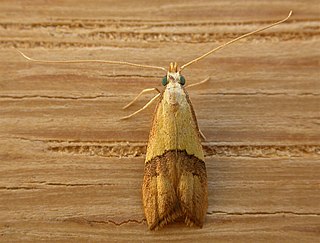
Crocanthes prasinopis is a species of moth of the family Lecithoceridae. It is found in most Australia and New Guinea.
Hierangela erythrogramma is a moth in the family Gelechiidae. It is found in Burma.
Lethata satyropa is a moth of the family Depressariidae. It is found in French Guiana.
Orphnolechia acridula is a moth of the family Depressariidae first described by Edward Meyrick in 1918. It is found in French Guiana.
Crocanthes perigrapta is a moth in the family Lecithoceridae. It was described by Edward Meyrick in 1904. It is found in Australia, where it has been recorded from Queensland, New South Wales and South Australia.
Crocanthes sidonia is a moth in the family Lecithoceridae. It was described by Edward Meyrick in 1910. It is found on New Guinea and Australia, where it has been recorded from Queensland.
Crocanthes pancala is a moth in the family Lecithoceridae. It was described by Turner in 1919. It is found in Australia, where it has been recorded from Queensland.
Crocanthes scioxantha is a moth in the family Lecithoceridae. It was described by Edward Meyrick in 1910. It is found on New Guinea.
Crocanthes sceletopa is a moth in the family Lecithoceridae. It was described by Edward Meyrick in 1910. It is found on the Maluku Islands in Indonesia.
Eclecta is a monotypic moth genus in the family Depressariidae. Its only species, Eclecta aurorella, has been found in the Australian state of New South Wales. Both the genus and species were first described by Edward Meyrick in 1883.
Comotechna parmifera is a moth in the family Depressariidae. It was described by Edward Meyrick in 1921. It is found in Peru and Pará, Brazil.
Scorpiopsis rhodoglauca is a moth in the family Depressariidae. It was described by Edward Meyrick in 1930. It is found in Australia, where it has been recorded from Queensland.
Coptotelia nigriplaga is a moth in the family Depressariidae. It was described by Paul Dognin in 1904. It is found in Colombia and Ecuador.
Gonionota comastis is a moth in the family Depressariidae. It was described by Edward Meyrick in 1909. It is found in Peru and Colombia.
Gonionota erotopis is a moth in the family Depressariidae. It was described by Edward Meyrick in 1926.
Gonionota oriphanta is a moth in the family Depressariidae. It was described by Edward Meyrick in 1928. It is found in Colombia.
Gonionota persistis is a moth in the family Depressariidae. It was described by Edward Meyrick in 1914. It is found in Peru.
Hypercallia argyropa is a moth in the family Depressariidae. It was described by Edward Meyrick in 1914. It is found in Peru.
Hypercallia cyathopa is a moth in the family Depressariidae. It was described by Edward Meyrick in 1913. It is found in Colombia.
Hypercallia orthochaeta is a moth in the family Depressariidae. It was described by Edward Meyrick in 1913. It is found in Peru.
